
Maximizing Network Bandwidth: A Guide for IT Professionals in the Field of Informational Technology
Maximizing Network Bandwidth: A Guide for IT Professionals in the Field of Informational Technology
In today’s fast-paced digital landscape, where information travels at the speed of light, the importance of maximizing network bandwidth cannot be overstated. For IT professionals, navigating the challenges of network performance is not just about ensuring connectivity—it’s about delivering seamless and efficient experiences for users.
Understanding Network Bandwidth
Network bandwidth essentially refers to the maximum rate of data transfer across a network path. Think of it as a highway: the more lanes available, the more vehicles (or data) can travel simultaneously. In the realm of informational technology, a bottleneck in bandwidth can lead to slowed applications, frustrated users, and ultimately, a profound impact on business productivity. Thus, understanding how to manipulate and maximize this bandwidth is crucial for any IT professional.
Assessing Current Bandwidth Usage
The first step in improving network bandwidth is to evaluate your current usage. Using network monitoring tools, you can identify which applications consume the most bandwidth and assess whether they align with business needs. IT professionals should routinely analyze traffic patterns to pinpoint peak usage times and determine if there are anomalies affecting performance.
Prioritizing Traffic with Quality of Service (QoS)
Incorporating Quality of Service (QoS) into your network management strategy allows you to prioritize certain types of traffic, ensuring that critical applications receive the bandwidth they require. For instance, video conferencing tools and cloud services often need priority over less critical traffic, such as file downloads. Implementing QoS can dramatically improve the end-user experience and optimize operational efficiency.
Employing Bandwidth Management Tools
Bandwidth management tools offer a way to optimize how bandwidth is distributed among users and applications. These tools can help in shaping bandwidth, throttling non-essential traffic, and even scheduling certain tasks during off-peak hours. For IT professionals, leveraging such tools can not only enhance performance but also provide better control over network resources.
Upgrading Network Infrastructure
If current bandwidth demands regularly exceed capacity, it may be time to consider an upgrade to network infrastructure. Investing in higher bandwidth connections and more efficient hardware can lead to significant improvements in performance. Technologies such as fiber optics provide enhanced speed and reliability, making them a preferred choice for organizations looking to future-proof their networks.
Implementing Network Optimization Techniques
There are several network optimization techniques that can be employed to maximize network bandwidth. Techniques such as data compression can reduce the amount of data transmitted, while caching frequently accessed content can significantly decrease load times. Additionally, content delivery networks (CDNs) can help distribute the load, bringing resources closer to users and alleviating pressure on the primary server.
Educating Users on Bandwidth Consumption
User behavior can heavily influence network performance. Educating users about responsible bandwidth consumption—such as minimizing large downloads during peak hours or using bandwidth-efficient applications—can lead to a more stable network. As an IT professional, fostering a culture of awareness about bandwidth usage within the organization is key to maximizing network potential.
By implementing these strategies, IT professionals can take significant strides towards optimizing network bandwidth, ensuring that both users and applications can operate at peak performance in an increasingly digital world. The commitment to providing a robust and capable network in the field of informational technology is what sets successful IT teams apart from the rest.

